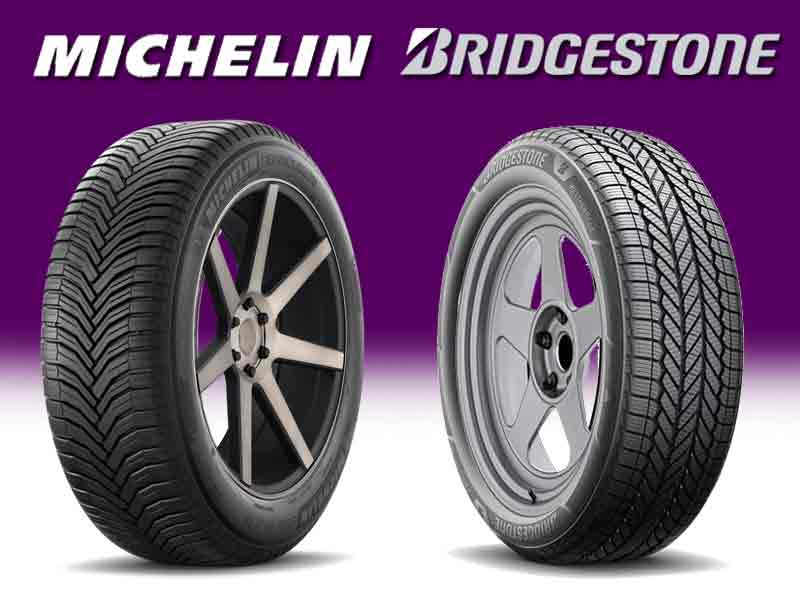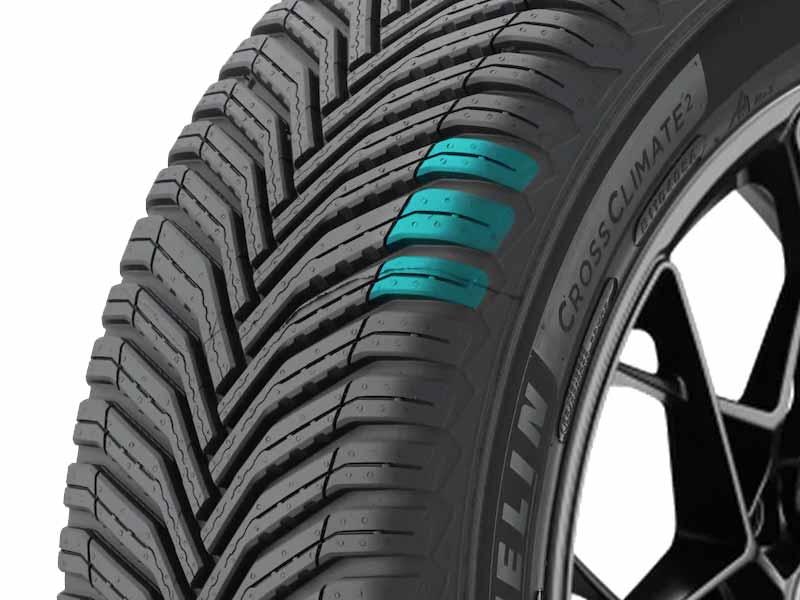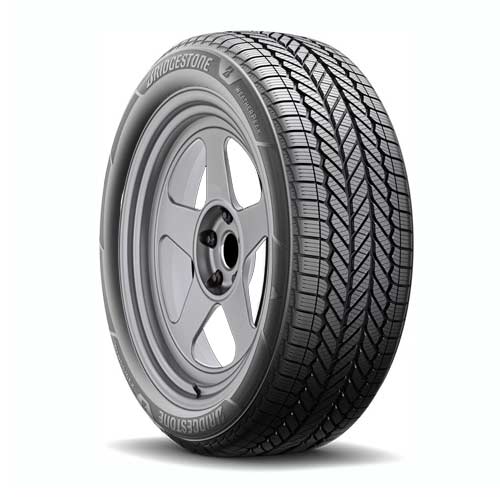In the realm of winter tires, the Michelin CrossClimate 2 and the Bridgestone Weatherpeak often go head to head. Each offers impressive traction and handling in snowy and icy conditions. So, who takes the crown? Let’s evaluate.
Table of Contents
Test Scores – Out of 10
| Bridgestone Weatherpeak | Crossclimate 2 | |
| Dry Traction | 9 | 9 |
| Wet Traction | 9 (Better) | 7 |
| Snow Traction | 7 | 9 (Better) |
| Ice Traction | 7 | 10 (Better) |
| Fuel Efficiency | 8 | 6 |
| Tread Life | 8 (Better) | 7 |
| Ride Comfort | 9 | 9 |
Design Comparison
Let’s start with Crossclimate 2.


The tire features a very straight forward directional design, where it’s elongated lugs offer an array of tread biters.
Speaking of siping first, these lugs have them oriented in all directions. You can see longitudinal slits of wide pattern, making a “cross” with laterally oriented ones as well.
Moreover, these lugs also feature interlocking sipes towards the very middle, where lugs are more closed up together.
And yes, all these lugs have snow vices, which basically are made to provide snow gripping capabilities. But more on that later.
Let’s move towards the design of Bridgestone Weatherpeak for now.

This tire features an symmetrical tread design, where 4 ribs in the middle are divided up form the shoulder lugs prominently. So naturally the tire gets to be more voided up.
Speaking of which, the grooves make a web, as all these circumferential voids are interconnected with each other, laterally.
Moreover, all these lugs have sharp chamfered edges, and they carry interlocking siping.
These sipes, though are different on the shoulders, where its only rectilinear.
Tire Sizes Facts
| Bridgestone Weatherpeak | Crossclimate 2 | |
| Sizes | 15 to 20″ | 16 to 22″ |
| Speed Rating | T, H and V. | H and V |
| Weight Range | 17 to 30 lbs | 25 to 36.5 lbs |
| Tread Depth | 10/32″ (on all) | 10/32″ (on all) |
| 3PMSFR | Yes | Yes |
Wet Traction
The overall wet traction is typically judged based on two crucial factors, predominately, where one is the resistance to hydroplaning and the other is the grip on wet surfaces.
Now comparing both tires, the Michelin CrossClimate 2 is somewhat in the grip department, as the tire’s design doesn’t allow it to have ample siping.
But why sipes are important?
Well, because these are small slits within the tread that act like water vacuums to ensure a firm tread-to-surface contact.
So although majority of water gets cleared off with grooves, the rest has to be sucked in by sipes, so the rubber can grip on the relatively dried up surface.
Though the tire because of its directional V-shaped tread design, proves to be quite a star, when it comes to hydroplaning resistance.
It’s swooping arms proficiently redirect incoming water, more effectively, allowing for faster float speeds (on average).
The Bridgestone WeatherPeak on the other side, excels, courtesy of its deep, interlocking sipes that stand strong, offering a consistently superior handling performance in a variety of wet conditions.
So this tire offers superior directional and lateral wet traction, in comparison.
Fuel Consumption
Fuel consumption is a critical aspect, as it directly impacts the tire’s value for money.
And since it depends on the tire’s rolling resistance, it makes sense why here, the Bridgestone WeatherPeak gets to be better.
The tire basically leverages its advantage with a lighter overall structure, which inherently doesn’t put as much pressure on the tread, as the tire rolls against the ground, reducing overall friction values, and thereby improving fuel economy.
Conversely, the CrossClimate 2, with its slightly more aggressive tread pattern (where it’s more voided up laterally), gets to lack.
Basically the lateral voids aren’t as streamlined to roll straight, compared to the WeatherPeak’s longitudinal ribs which are.
Tread Noise
When considering noise generation, a common issue for drivers, both tires manage to put up a commendable show.
The WeatherPeak brings in Whisper Grooves technology, which essentially involves placing connectors or ridges between the shoulder blocks of the tire. This simple yet ingenious technique restricts the entry of air particles, consequently reducing noise.
(This is because air particles striking the walls of the tread, is what creates noise).
On the other side, the Michelin Crossclimate 2 is also not so bad. It although doesn’t restrict as much air to get in, it still effectively handles noise with its Variable Pitch technology.
Moreover, it also features laterally streamlined lugs, which encourage air to flow smoothly without causing as much of the overall noisy collision with the tread walls.
Dry Traction
When it comes to dry traction, there are two things to consider, directional grip, and lateral traction. And considering both tires, we have some mixed results.
The Michelin Crossclimate 2 offers a more packed up central lug area, and a rounded contact patch, and both of these features allow this tire to have shorter braking distance (on tests, on average).
Whereas, the Bridgestone WeatherPeak shows up with superior handling times, and it makes sense, because, one, the tire isn’t too voided up on shoulders. And two, its lighter.
With smaller lateral voids, it offers more of its rubber to meet the ground. But why shoulders? Well because as the tire corners, the weight on it shifts towards shoulders/sidewalls, due to inertia.
Moreover, with lighter structure, these shoulder lugs aren’t that susceptible to bend as much, relatively speaking.
And this allows for a better under and oversteering balance, which then provides faster steering response.
Durability and Treadwear
Durability wise, both tires are similar, as they both offer similar internal construction, including wide steel belts, a seamless full-cover reinforcement ply, and folded belt-edge tape.
But when it comes to tread life, the Crossclimate 2 takes the back seat, as its tread is relatively softer.
And this softer rubber make up, combined with the fact, that the tire shows up with greater rolling resistance, the tire isn’t as long lasting as the WeatherPeak.
Though, keep in mind, that the difference isn’t a lot between the two, still.
Winter Performance
Finally, we arrive at winter performance, and this is where the Michelin CrossClimate 2 truly shines.
Its elongated lugs, combined with snow vices and central interlocking sipes, show their mettle by effectively scooping up slush and snow.
And yes, its narrower section width, combined with its heavier, comparatively, weight, it gets to exert more pressure on the snow, allowing for superior snow-to-snow contact.
But how is that important?
Well, because snow adheres to other snow particles with greater friction, compared to what it would with the tread’s rubber.
Summary
Michelin CrossClimate 2 excels in:
- Hydroplaning Resistance: Thanks to its V-shaped tread design, the CrossClimate 2 effectively redirects water, thereby performing better in hydroplaning resistance.
- Directional Traction: With a more packed central lug area and a rounded contact patch, it achieves shorter braking distances.
- Winter Performance: The tire, due to its elongated lugs, snow vices, central interlocking sipes, narrower section width, and comparatively heavier weight, provides superior snow-to-snow contact, enhancing its winter performance.
Bridgestone WeatherPeak excels in:
- Wet Traction, courtesy of its deep, interlocking sipes, provides superior handling performance in a variety of wet conditions, offering better directional and lateral wet traction.
- Fuel Consumption: Due to its lighter structure, where it has less rolling resistance.
- Tread Noise: Thanks to its Whisper Grooves technology, which restricts the entry of air particles, effectively managing noise generation.
- Lateral Traction: Owing to its smaller lateral voids and lighter structure.
- Durability and Treadwear: The WeatherPeak, with its harder tread, has a longer lifespan compared to the CrossClimate 2.